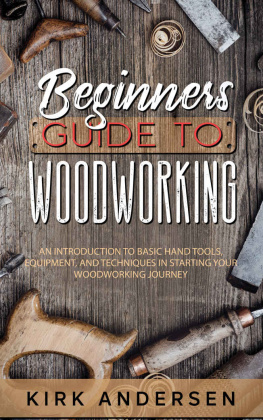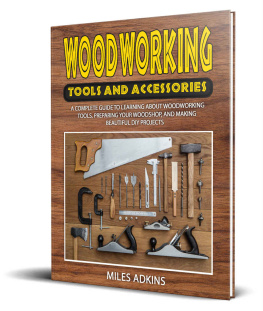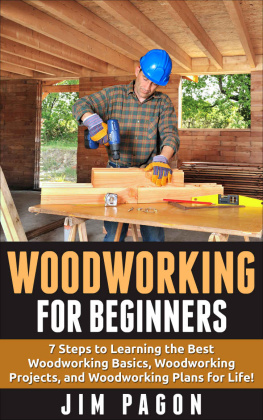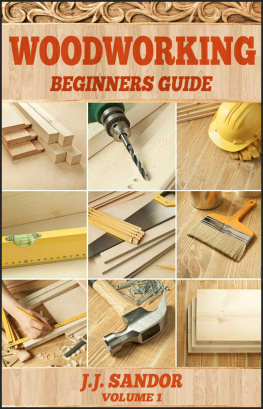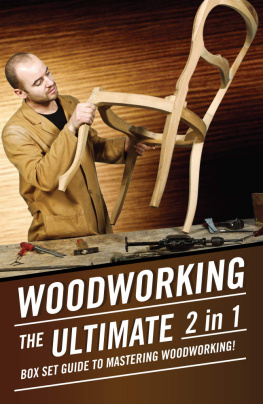Nils Johansson - Woodworking for Beginners : Woodworking Tools & Accessories
Here you can read online Nils Johansson - Woodworking for Beginners : Woodworking Tools & Accessories full text of the book (entire story) in english for free. Download pdf and epub, get meaning, cover and reviews about this ebook. year: 2020, genre: Home and family. Description of the work, (preface) as well as reviews are available. Best literature library LitArk.com created for fans of good reading and offers a wide selection of genres:
Romance novel
Science fiction
Adventure
Detective
Science
History
Home and family
Prose
Art
Politics
Computer
Non-fiction
Religion
Business
Children
Humor
Choose a favorite category and find really read worthwhile books. Enjoy immersion in the world of imagination, feel the emotions of the characters or learn something new for yourself, make an fascinating discovery.

- Book:Woodworking for Beginners : Woodworking Tools & Accessories
- Author:
- Genre:
- Year:2020
- Rating:3 / 5
- Favourites:Add to favourites
- Your mark:
- 60
- 1
- 2
- 3
- 4
- 5
Woodworking for Beginners : Woodworking Tools & Accessories: summary, description and annotation
We offer to read an annotation, description, summary or preface (depends on what the author of the book "Woodworking for Beginners : Woodworking Tools & Accessories" wrote himself). If you haven't found the necessary information about the book — write in the comments, we will try to find it.
Woodworking for Beginners : Woodworking Tools & Accessories — read online for free the complete book (whole text) full work
Below is the text of the book, divided by pages. System saving the place of the last page read, allows you to conveniently read the book "Woodworking for Beginners : Woodworking Tools & Accessories" online for free, without having to search again every time where you left off. Put a bookmark, and you can go to the page where you finished reading at any time.
Font size:
Interval:
Bookmark:
WOODWORKING FOR BEGINNERS
Woodworking Tools & Accessories
NILS JOHANSSON
Copyright
All rights reserved. No part of this book may be reproduced in any form or by any electronic, print or mechanical means, including information storage and retrieval systems, without permission in writing from the publisher.
Copyright 2020 Nils Johansson
Disclaimer
Purchasing this book can be seen as consent to the fact that both the publisher and the author of this book are in no way experts on the topics discussed within. This book is developed with the goal of providing information that is as accurate and reliable as possible. Under no circumstances will any legal responsibility or blame be held against the publisher for any reparation, damages, or monetary loss due to the information herein, either directly or indirectly. This declaration is deemed fair and valid by both the American Bar Association and the Committee of Publishers Association and is legally binding throughout the United States. There are no scenarios in which the publisher or the original author of this work can be in any fashion deemed liable for any hardship or damages that may befall the reader or anyone else after undertaking information described herein. The information in the following pages is intended only for informational functions. As befitting its nature, it is presented without assurance regarding its prolonged validity or interim quality. Trademarks that are mentioned are done without written consent and can in no way be considered an endorsement from the trademark holder.
Table of Contents
If you are new to woodworking, you may be wondering where to begin. Its always a good idea to start with a few hand tools, such as a couple of planes, a set of chisels, some layout tools, and a handsaw.
Using hand tools requires patience and a measure of skill, but in the procedure, youll learn all about grain direction, accurate layout, and the importance of sharp tools.
As you learn to cut and fit a dovetail joint or cautiously shape the sensual curves of a table leg, the hand tools will create textures and surfaces that distinctly say, Handmade.
Learning to use power tools can be equally satisfying; woodworking machines provide accuracy and efficiency thats difficult to match with hand tools. The table saw is the first power tool that many woodworkers purchase. It can accurately rip and crosscut as well as cut many joints.
The jointer and planer are a team that can efficiently flatten and plane lumber to size. Almost every woodworking shop has a band saw; its the tool of choice for cutting curves and the only tool that can resaw book-matched panels and veneer.
Mostly, power and hand tools are of equal importance: Machines provide efficiency for labour-intensive tasks, such as sawing and planing; hand tools are used to create fine details that machines cant duplicate.
As you peruse the pages of this book, I hope that youll learn many new skills while experiencing the intense enjoyment that woodworking provides. First, we are going to start looking into some safety tips for beginners.
Next, you will learn how to use the Circular saw, how to eliminate and install Circular saw blades, how to perform basic cuts and crosscutting. After that, you will learn how to use an electric drill, how to use spade bits and Hole saw, and how to Drill a dowel joint.
Next, we are going to look at Sanding and Scraping and how to use a drum sander. After that, we are going to look at working with a router, how to adjust a standard router, how to make a stopped grove, how to use a standard router, how to work with a plunge router, and how to joint with a router table.
Next, you will learn how to use a Saber Saw, how to install and square the blade, how to make an interior cut, and how to do repeated curved cuts. Moving on, you will learn how to use a Sander, Orbital sander, Plate Joiner, how to add a shelf to a carcase, and how to join bevelled corners.
Next, we are going to look at Edge Tools, Measuring and marking tools, Sharpening Tools, Honing Tools and how to sharpen chisels & scrapers. Then, you will learn about Planing Techniques, Scraping Techniques, Sanding Techniques, Patching Techniques and Graining Techniques.
After that, we are going to look at how to use a random-orbit sander on curved surfaces, and how to repair damaged surfaces. Lastly, we are going to cover how to change the Wood colour, Bleaching Techniques, Wood Stains Variations, Dye Stains, Pigment Stains, how to stain wood, how to pickle a wood surface, how to Apply Compound Stain, and how to use a fuming tent.
There are many more topics we will cover in this book, and hope this summary will get you exited on reading this book. If you are ready, lets begin by looking at some safety tips that you should be aware.
Without the appropriate safety gear and precautions, short-term exposure to these solvents can outcome in irritation to the skin, eyes, and throat, as well as dizziness, headache, nausea and shortness of breath.
Longer-term exposure poses more potential risks; some effects may not be apparent until you have used the substances for months or even years. In addition to the health risks, most of these solvents are flammable.
Some oil-derived merchandise like linseed oil can catch fire spontaneously at room temperature if its not sufficiently concentrated. When vaporized in a small enough concentration of air, a small quantity of lacquer thinner can cause a life-threatening explosion.
All this is not to suggest that working with finishing merchandises has to be dangerous-only that it can be if you take a cavalier attitude towards the risks. If you spray finishes, consider buying a spray booth or constructing a spray room of your own.
As most of the harm from organic solvents come from inhalation, wear a dual-cartridge respirator, mainly if you are spraying or will be exposed to fumes for more than an hour.
To prevent eye injury, wear satiety goggles, and rubber gloves when working with caustic or toxic finishing merchandises. Whenever possible, select a product that combines the finish you want with low volatility and toxicity.
Work with the windows open, and use a certified spark-profane to keep the air moving. This will help prevent the fumes in your work area from reaching a toxic or flammable level.
If you have drowsiness, fatigue, headache, blurred vision, weakness, numbness, irritation of the eyes, skin or throat, shortness of breath, or a loss of coordination while finishing, stop immediately and leave the work area until the symptoms clear. Afterward, ventilate the work area thoroughly fully and use a different finishing product.
Wear appropriate safety tools: safety glasses, a face or dust mask if you are using sanding accessories, and heading protector when you are operating tools for an extended period of time.
- Clamp all work pieces secure wherever possible to keep both hands free to operate the tools.
- Be aware of the position of the power cord at all times.
- Make all adjustments to the tools with the tool unplugged.
- Maintain and clean tools averagely.
- Keep all blades and bits sharp, clean and undamaged.
- Check periodically for loose parts and frayed cords.
- Never carry a connected tool with your finger on the trigger.
- Tie back long hair.
- Roll-up sleeves, and avoid wearing loose clothing.
- Eliminate rings and other jewellery that can be catched accidentally in moving parts.
- Do not over-reach.
- Keep your balance at all times.
- Ensure that lighting and ventilation in the work area are adequate.
- Do not use tools if the floor is damp or wet.
- Keep your work area clean and tidy, as clutter can lead to accidents.
Font size:
Interval:
Bookmark:
Similar books «Woodworking for Beginners : Woodworking Tools & Accessories»
Look at similar books to Woodworking for Beginners : Woodworking Tools & Accessories. We have selected literature similar in name and meaning in the hope of providing readers with more options to find new, interesting, not yet read works.
Discussion, reviews of the book Woodworking for Beginners : Woodworking Tools & Accessories and just readers' own opinions. Leave your comments, write what you think about the work, its meaning or the main characters. Specify what exactly you liked and what you didn't like, and why you think so.


